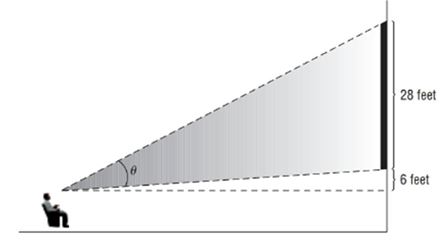
Concept explainers
Movie Theater Screens Suppose that a movie theater has a screen that is 28 feet tall. When you sit down, the bottom of the screen is 6 feet above your eye level. The angle formed by drawing a line from your eye to the bottom of the screen and another line from your eye to the top of the screen is called the viewing angle. In the figure, is the viewing angle. Suppose that you sit feet from the screen. The viewing angle is given by the function .

What is your viewing angle if you sit 10 feet from the screen? 15 feel? 20 feel?
If there are 5 feet between the screen and the first row of seats and there are 3 feet between each row and the row' behind it. which row results in the largest viewing angle?
Using a graphing utility, graph .
What value of results in the largest viewing angle?
To find:
a. What is your viewing angle if you sit 10 feet from the screen? 15 feet? 20 feet?
Answer to Problem 76AYU
a.
Explanation of Solution
Given:
Suppose that a movie theater has a screen that is 28 feet tall. When you sit down, the bottom of the screen is 6 feet above your eye level. The angle formed by drawing a line from your eye to the bottom of the screen and another line from your eye to the top of the screen is called the viewing angle. In the figure, is the viewing angle. Suppose that you sit feet from the screen. The viewing angle is given by the function,

Calculation:
a. What is your viewing angle if you sit 10 feet from the screen?
What is your viewing angle if you sit 15 feet from the screen?
What is your viewing angle if you sit 20 feet from the screen?
To find:
b. If there are 5 feet between the screen and the first row of seats and there are 3 feet between each row and the row behind it, which row results in the largest viewing angle?
Answer to Problem 76AYU
b. Fourth row.
Explanation of Solution
Given:
Suppose that a movie theater has a screen that is 28 feet tall. When you sit down, the bottom of the screen is 6 feet above your eye level. The angle formed by drawing a line from your eye to the bottom of the screen and another line from your eye to the top of the screen is called the viewing angle. In the figure, is the viewing angle. Suppose that you sit feet from the screen. The viewing angle is given by the function,

Calculation:
b. The viewing angle in the first row (5feet),
The viewing angle in the second row (8feet),
The viewing angle in the third row (11feet),
The viewing angle in the fourth row (14feet),
The viewing angle in the fifth row (17feet),
The viewing angle in the sixth row (20 feet),
The largest viewing angle in fourth row.
To find:
c. What value of results in the largest viewing angle?
Answer to Problem 76AYU
c. 14 feet.
Explanation of Solution
Given:
Suppose that a movie theater has a screen that is 28 feet tall. When you sit down, the bottom of the screen is 6 feet above your eye level. The angle formed by drawing a line from your eye to the bottom of the screen and another line from your eye to the top of the screen is called the viewing angle. In the figure, is the viewing angle. Suppose that you sit feet from the screen. The viewing angle is given by the function,

Calculation:
c.

14 feet is in the largest viewing angle.
Chapter 7 Solutions
Precalculus
Additional Math Textbook Solutions
Thinking Mathematically (6th Edition)
Introductory Statistics
Calculus: Early Transcendentals (2nd Edition)
Elementary Statistics: Picturing the World (7th Edition)
University Calculus: Early Transcendentals (4th Edition)
A First Course in Probability (10th Edition)
- Please as many detarrow_forward8–23. Sketching vector fields Sketch the following vector fieldsarrow_forward25-30. Normal and tangential components For the vector field F and curve C, complete the following: a. Determine the points (if any) along the curve C at which the vector field F is tangent to C. b. Determine the points (if any) along the curve C at which the vector field F is normal to C. c. Sketch C and a few representative vectors of F on C. 25. F = (2½³, 0); c = {(x, y); y − x² = 1} 26. F = x (23 - 212) ; C = {(x, y); y = x² = 1}) , 2 27. F(x, y); C = {(x, y): x² + y² = 4} 28. F = (y, x); C = {(x, y): x² + y² = 1} 29. F = (x, y); C = 30. F = (y, x); C = {(x, y): x = 1} {(x, y): x² + y² = 1}arrow_forward
- ٣/١ B msl kd 180 Ka, Sin (1) I sin () sin(30) Sin (30) اذا ميريد شرح الكتب بس 0 بالفراغ 3) Cos (30) 0.866 4) Rotating 5) Synchronous speed, 120 x 50 G 5005 1000 s = 1000-950 Copper bosses 5kW Rotor input 5 0.05 : loo kw 6) 1 /0001 ined sove in peaper I need a detailed solution on paper please وه اذا ميريد شرح الكتب فقط ١٥٠ DC 7) rotor a ' (y+xlny + xe*)dx + (xsiny + xlnx + dy = 0. Q1// Find the solution of: ( 357arrow_forward۳/۱ R₂ = X2 2) slots per pole per phase 3/31 B. 180 msl Kas Sin (I) 1sin() sin(30) Sin (30) اذا ميريد شرح الكتب بس 0 بالفراغ 3) Cos (30): 0.866 4) Rotating 5) Synchronous speeds 120×50 looo G 1000-950 1000 Copper losses 5kw Rotor input 5 loo kw 0.05 6) 1 اذا ميريد شرح الكتب فقط look 7) rotor DC ined sove in peaper I need a detailed solution on paper please 0 64 Find the general solution of the following equations: QI//y(4)-16y= 0. Find the general solution of the following equations: Q2ll yll-4y/ +13y=esinx.arrow_forwardR₂ = X2 2) slots per pole per phase = 3/31 B-180 60 msl kd Kas Sin () 2 I sin (6) sin(30) Sin (30) اذا مريد شرح الكتب بس 0 بالفراغ 3 Cos (30) 0.866 4) Rotating ined sove in peaper 5) Synchronous speed s 120×50 6 s = 1000-950 1000 Copper losses 5kw Rotor input 5 0.05 6) 1 loo kw اذا ميريد شرح الكتب فقط Look 7) rotov DC I need a detailed solution on paper please 0 64 Solve the following equations: 0 Q1// Find the solution of: ( y • with y(0) = 1. dx x²+y²arrow_forward
- R₂ = X2 2) slots per pole per phase = 3/3 1 B-180-60 msl Ka Sin (1) Isin () sin(30) Sin (30) اذا ميريد شرح الكتب بس 0 بالفراغ 3) Cos (30) 0.866 4) Rotating 5) Synchronous speed, 120 x 50 s = 1000-950 1000 Copper losses 5kw Rotor input 5 6) 1 0.05 G 50105 loo kw اذا ميريد شرح الكتب فقط look 7) rotov DC ined sove in peaper I need a detailed solution on paper please 064 2- A hot ball (D=15 cm ) is cooled by forced air T.-30°C, the rate of heat transfer from the ball is 460.86 W. Take for the air -0.025 Wim °C and Nu=144.89, find the ball surface temperature a) 300 °C 16 b) 327 °C c) 376 °C d) None か = 750 01arrow_forwardDon't do 14. Please solve 19arrow_forwardPlease solve 14 and 15arrow_forward
- 1. Consider the following system of equations: x13x2 + 4x3 - 5x4 = 7 -2x13x2 + x3 - 6x4 = 7 x16x213x3 - 21x4 = 28 a) Solve the system. Write your solution in parametric and vector form. b) What is a geometric description of the solution. 7 c) Is v = 7 in the span of the set S= [28. 1 HE 3 -5 3 ·6 ? If it is, write v 6 as a linear combination of the vectors in S. Justify. d) How many solutions are there to the associated homogeneous system for the system above? Justify. e) Let A be the coefficient matrix from the system above. Find the set of all solutions to Ax = 0. f) Is there a solution to Ax=b for all b in R³? Justify.arrow_forward4. Suppose that A is made up of 5 column vectors in R³, and suppose that the rank(A)=3. a. How many solutions are there to Ax=0? Justify. b. What is a geometric description for the nullspace(A)? Justify. c. Do the column vectors of A span R³? Justify. d. Is A invertible? Justify.arrow_forward3. Suppose that A is 5 x 5 and rank(A)=4. Use this information to answer the following. a. Give a geometric description of nullspace(A). Justify. b. Is A invertible? Justify. c. Give a geometric description of the span of the column vectors of A. What space are the column vectors of A in? Justify. d. What is determinant of A? Justify.arrow_forward
 Calculus: Early TranscendentalsCalculusISBN:9781285741550Author:James StewartPublisher:Cengage Learning
Calculus: Early TranscendentalsCalculusISBN:9781285741550Author:James StewartPublisher:Cengage Learning Thomas' Calculus (14th Edition)CalculusISBN:9780134438986Author:Joel R. Hass, Christopher E. Heil, Maurice D. WeirPublisher:PEARSON
Thomas' Calculus (14th Edition)CalculusISBN:9780134438986Author:Joel R. Hass, Christopher E. Heil, Maurice D. WeirPublisher:PEARSON Calculus: Early Transcendentals (3rd Edition)CalculusISBN:9780134763644Author:William L. Briggs, Lyle Cochran, Bernard Gillett, Eric SchulzPublisher:PEARSON
Calculus: Early Transcendentals (3rd Edition)CalculusISBN:9780134763644Author:William L. Briggs, Lyle Cochran, Bernard Gillett, Eric SchulzPublisher:PEARSON Calculus: Early TranscendentalsCalculusISBN:9781319050740Author:Jon Rogawski, Colin Adams, Robert FranzosaPublisher:W. H. Freeman
Calculus: Early TranscendentalsCalculusISBN:9781319050740Author:Jon Rogawski, Colin Adams, Robert FranzosaPublisher:W. H. Freeman
 Calculus: Early Transcendental FunctionsCalculusISBN:9781337552516Author:Ron Larson, Bruce H. EdwardsPublisher:Cengage Learning
Calculus: Early Transcendental FunctionsCalculusISBN:9781337552516Author:Ron Larson, Bruce H. EdwardsPublisher:Cengage Learning





